Great Danish Designers 101: Niels Møller
The mission statement of furniture maker J.L. Møllers Møbelfabrik describes a “proud tradition of classic craftsmanship.” Founded in 1944 by Niels Møller, the company is now run by his son but adheres to his very exacting standards, producing many of Møller’s most cherished designs today using methods established over 70 years ago. Known for their exceptional quality, Møller’s original pieces are also in high demand on the collectors' market. (jlm.dk, Danish Teak Classics)
Niels Møller: Five Years Invested in Each Design
Niels Møller was born in 1920 in Århus, Denmark. After completing an apprenticeship in cabinetmaking in 1939, he enrolled at the Århus School of Design for further studies. In 1944 he opened his own furniture company, JL Møllers Møbelfabrik, in a small workshop in his hometown. By 1952 the company had begun exports to Germany and the US. With increased production, they found themselves in need of more space and opened a larger facility just outside of Århus in Højbjerg. By 1974 they were exporting to Japan where their minimalist designs proved extremely popular. Japan remains one of the company’s biggest markets today. (Design Within Reach)
Soon after setting up shop Møller was recognized for his “consistent excellence in quality and workmanship.” (Pamono) His son Jørgen elaborated in an interview about his father: “My father never compromised on anything…When he designed a chair, he would find the materials and then design the furniture. Each design took him five years to complete.” (Design Within Reach)
Such dedication meant that Møller produced far fewer designs than his contemporaries, but the relative scarcity of his pieces makes them even more valued.
The emphasis on old craft traditions endures at JL Møllers. Even today the company avoids the use of assembly lines and, as far as possible, modern technology. An outline of their processes shows the attention to detail in their furniture production:
- Each chair is handcrafted, with individual employees specializing in particular processes.
- Tenons, mortices, and dowels are all glued by hand. While other components are dried down to 8% humidity, dowels are dried down to 5%. As a result, when the dowel contacts the glue, “it expands and is immovably fixed in position.”
- Believing that polishing machines “treat all wood alike,” the company ensures that all chairs are polished by hand. With each chair getting individual attention, the best attributes of the wood can be brought out.
- After being thoroughly inspected, chairs are packed fully assembled, not as “knock-down furniture in a box.” The workmanship is so sound, the company states on its website that it is “literally impossible to pull a Møller chair apart.”
Production methods may be the same as they were in the mid-century period, but the choice of materials has narrowed. Rosewood, a favourite of Niels Møller, is now an endangered species and cannot be used today. The company continues to use teak in some of its designs, but works more often with oak, beech, and walnut, and sometimes cherry or maple.
One of the resulting adaptations the company has had to make is seen in the very popular Model 75 dining chair. Once made in teak, as shown below, new versions of the Model 75 are now only available in oak:
VHB’s original Model 75 chairs in teak with new Danish cord seating.
When describing a Møller chair, people use words like “sculptural,” “clean,” “simple,” and “timeless.” Those words are all applicable to the Model 75. The back, shown below, seems to be constructed of a single piece of wood. It is utterly absent of ornamentation, yet is still elegant and sophisticated in appearance. It is also curved ever so slightly to provide comfort.
Image from 1stdibs.
A similar aesthetic exists in Møller’s other dining chairs. The Model 78 in rosewood is a particularly striking example:
Images from Pamono.ca.
Again, the design is very simple, with only a subtle, pointed flourish on the front of the legs and the very top of the chair. The backs of these chairs are a testament to Møller’s exceptional workmanship: the horizontal and vertical pieces flow almost seamlessly into one another with the curves providing the sculptural quality he was known for.
His Model 65 armchair shows a similar grace, with tapered legs that create considerable lightness in appearance:
Images from 1stdibs.
Like many mid-century modern designers, Møller experimented with different shapes. The sharp angles of the Model 84 chair, created in the 1970s, contrast significantly with the sinuous curves of his earlier work, yet still have a similar sense of sculpture and flow:
Images from 1stdibs.
Inspired by nature and organic forms, Danish mid-century designers would create pieces that highlighted the natural grain of the woods they worked with. Rosewood, with its pronounced grain, was a favourite among designers from the period, including Møller. The pieces he created in rosewood are among his most beautiful. This round dining table is one example:
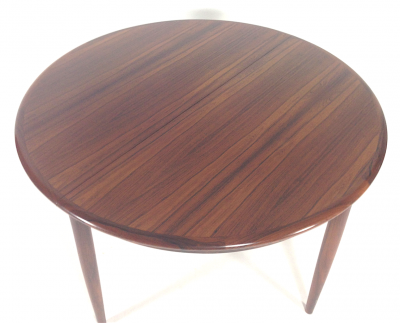
Images from Pamono.ca.
This Møller coffee table also showcases the natural beauty of rosewood:
Image from Scandinavian Modern.
Møller did not design a lot of sideboards, but he applied his usual attention to detail when he did. In the sideboard below, he used the wood’s natural grain to create symmetry between the two doors:
The interior is equally eye-catching, with darker hues used for the shelves for contrast:
Images from 1stdibs.
In the larger sideboard shown below, the wood grain is more subtle but still provides a sense of symmetry. The interior shows typical mid-century Danish practicality, offering flexible storage with its adjustable shelves:
Images from 1stdibs.
By 1969 both of Møller’s sons had completed their training in cabinetmaking and joined the family business. Younger son Jørgen added to the company’s legacy with the Model 401, designed in 1974 while he was a student at the Copenhagen Design School. Although the overall feel of the chair is different, the influence of his father is clear in the workmanship and sculptural qualities:
Image from jlm.dk.
In 1981, the company received Dansk MøbelIndustri’s Furniture Prize. In explaining their choice, the jury mentioned J.L. Møllers Møbelfabrik’s “ability to combine the best craft traditions with modern furniture manufacture” and went onto say that the company “has always obstinately held firm to its high quality level.” (jlm.dk) Indeed it has, as both its new output and vintage pieces show.
Niels Moller passed away in 1982. His legendary company is still producing several of the models first made famous in the mid-century period, along with works from new designers. Niels’ son Jørgen is currently managing the company, with his son Michael following in his footsteps as the next generation to run the iconic firm.







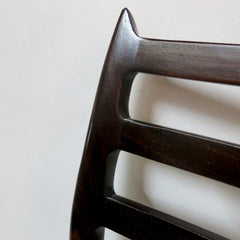


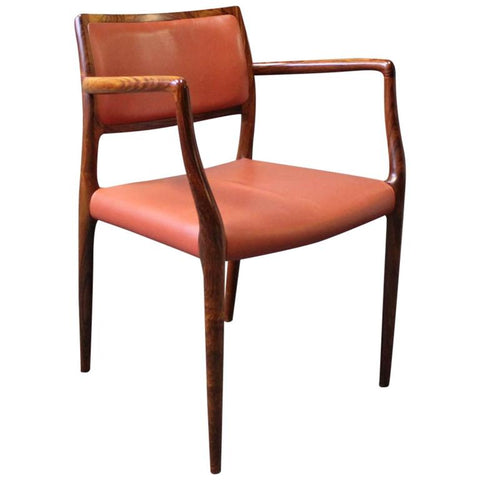


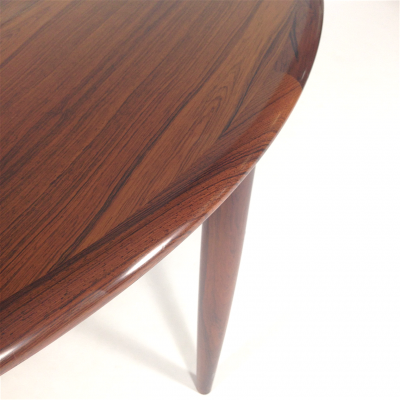

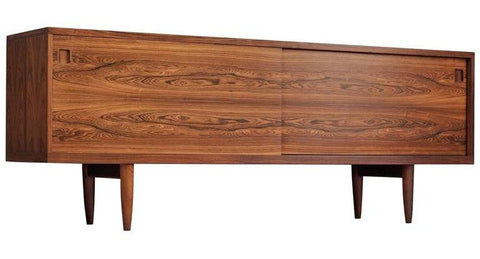




Leave a comment